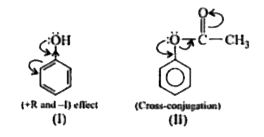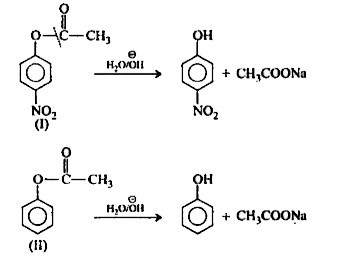Which of the following statements is/are correct?
A
The nitration of phenol is faster than phenyl acetate.
B
The reaction of is faster than  with
with
C
Base-catalysed hydrolysis of p-nitrophenyl acetate is faster than phenyl acetate.
D
Acid-catalysed esterification of PhOH is faster than p-nitrophenol with MeCOOH.
Text Solution
The correct Answer is:A, B, C, D
(A) SE reaction is favoured by EDG, less favoured by EWG

Due to cross-conjugation in (II), donating power of oxygen to the ring decreases and hence it is less reactive then (I)
(B) Acidic character: 
Basic and nucleophilic character.

Since, PhO is a stronger nucleophilic then . Hence, it reacts faster with .
(C) 
As we know, (I) is faster then (II) . The -withdrawing effect of (p-NO) group (-R and -I), from O makes a weaker base and better leaving group.
(D) Esterification of PhOH is faster than p-nitrophenol. Phenol, a less acidic compound (or more basic) is more reactive in acidic conditions. With its -withdrawing group, p-nitrophenol is less basic and less reactive.
|
Topper's Solved these Questions
- ALCOHOLS, PHENOLS AND ETHERSBOOK - BRILLIANT PUBLICATIONCHAPTER - ALCOHOLS, PHENOLS AND ETHERSEXERCISE - LEVEL III (Numerical Type)
6 Videos
- ALCOHOLS, PHENOLS AND ETHERSBOOK - BRILLIANT PUBLICATIONCHAPTER - ALCOHOLS, PHENOLS AND ETHERSEXERCISE - LEVEL III (Matching Column Type)
1 Videos
- ALCOHOLS, PHENOLS AND ETHERSBOOK - BRILLIANT PUBLICATIONCHAPTER - ALCOHOLS, PHENOLS AND ETHERSEXERCISE - LEVEL III (Single Correct Answer Type)
10 Videos
- ALCOHOL, PHENOL & ETHER BOOK - BRILLIANT PUBLICATIONCHAPTER - ALCOHOL, PHENOL & ETHER EXERCISE - LEVEL II (ASSERTION - REASON TYPE)
40 Videos
- ALDEHYDES AND KETONES BOOK - BRILLIANT PUBLICATIONCHAPTER - ALDEHYDES AND KETONES EXERCISE - LEVEL-II
42 Videos
Similar Questions
Knowledge Check
Which of the following statement is/are correct?
A[Ag(NH3)2]+ is linear with sp hybridised Ag+ ion.BNiCl2−4,VO3−4 and MnO−4 have tetrahedral geometry.C[Cu(NH3)4]2+,[Pt(NH3)4]2+ and [Ni(CN)4]2− have dsp2 hybridisation of the metal ions.DFe(CO)5 have trigonal bipyramidal structure with dsp3 hybridised iron.Which of the following statement is /are correct ?
AΔG∘fofH2(g) at 298 K is zeroBΔG∘fofD2(g) at 298 K is zeroCΔH∘fofH2(g)at 298 K is zeroDS∘ of H+(aq.) at 298 K is zeroWhich of the following statement is (are) correct?
A(a) It is possible to change the specific rate constant by changing the temperatureB(b) The specific rate constant is independent of the concentrations of the reacting speciesC(c ) In step-wise reaction the rate determining step is the slowest oneD(d) The rate of a catalysed reaction is always independent of the concentration of the catalyst
Which of the following statements is not correct?
View SolutionWhich of the following statements is not correct?
View SolutionWhich of the following statements is not correct?
View SolutionWhich of the following statements is not correct?
View SolutionWhich of the following statements is not correct?
View Solution
